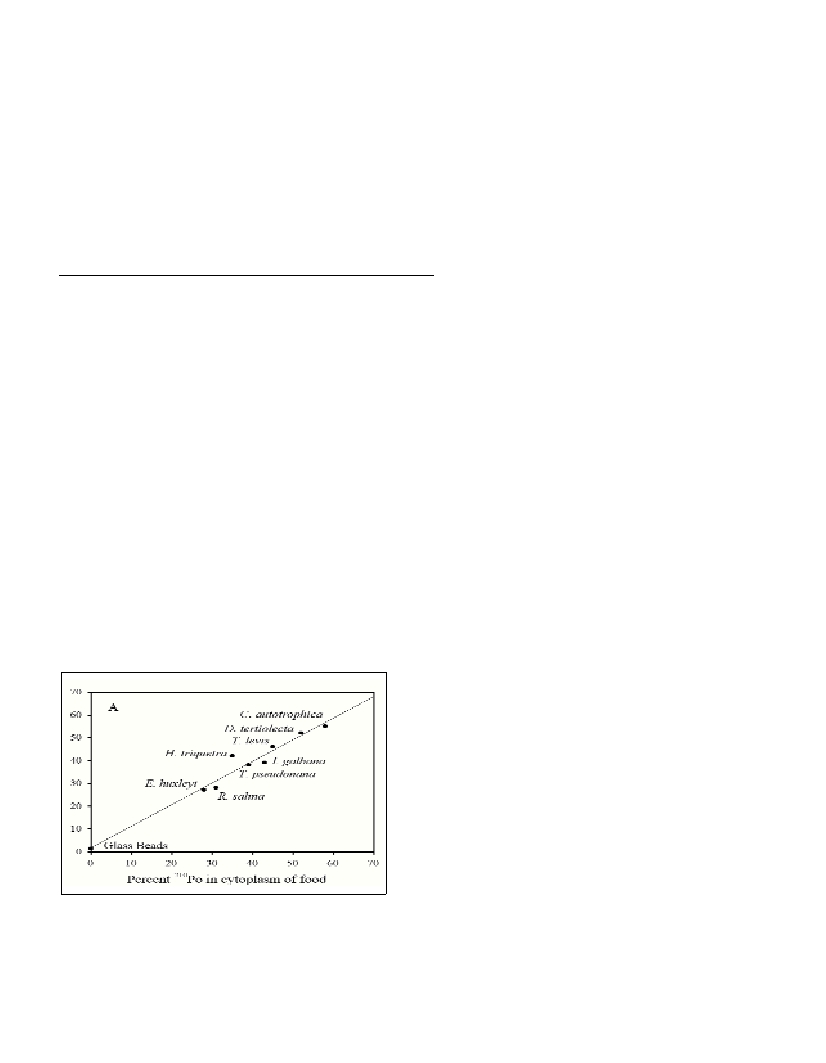Rapp. Comm. int. Mer Médit., 37,2004
245
THE BIOACCUMULATION OF
210
PO IN PLANKTON AND ITS POTENTIAL USE AS AN ORGANIC
CARBON TRACER AT THE DYFAMED SITE IN THE NORTHWESTERN MEDITERRANEAN
Gillian Stewart
1
*, Nicholas Fisher
1
, J. Kirk Cochran
1
, Scott Fowler
2
, Pere Masqué
3
1
Marine Sciences Research Center, Stony Brook University, USA - * gstewart@ic.sunysb.edu, nfisher@notes.cc.sunysb.edu,
kcochran@notes.cc.sunysb.edu
2
IAEA, Marine Environment Laboratory, Monaco - S.Fowler@iaea.org
3
Institut de Ciència i Tecnologia Ambientals, Universitat Autònoma de Barcelona, Bellaterra, Spain - Pere.Masque@uab.es
Abstract
The natural radionuclide polonium-210 becomes concentrated in marine biota and may be an excellent tracer for the export of particulate
organic matter from the sea surface to depth. Based on laboratory experiments,
210
Po’s distribution inside plankton is similar to that of
protein, and the radionuclide is lost from decomposing marine particles as organic carbon is lost. Preliminary profiles of particulate
polonium at the DYFAMED site correspond well to particulate organic carbon (POC) profiles. Results from controlled laboratory uptake,
trophic transfer, desorption, and decomposition experiments will be used to interpret field data.
Keywords: Polonium, Bioaccumulation, Organic Carbon Flux, DYFAMED
Polonium-210 (half-life = 138 d), the final alpha-emitting product
of the
238
U decay series, is produced in seawater from the decay of its
grandparent
210
Pb.
210
Po is found at sub-trace concentrations in
seawater (10
-20
M) and displays a nutrient-like profile with depth,
partly as a result of the distribution of
210
Pb (1).
210
Po becomes highly
concentrated in marine organisms and can contribute significantly to
human radioactivity exposure through seafood consumption (2). In
addition, due to its high particle reactivity, polonium has been used to
trace the vertical ?ux of particulate matter in the ocean (3,4). Unlike
thorium-234, which is a well-documented particle surface area tracer
(5),
210
Po has a high specific affinity for organic matter and protein
(3) and may provide more information about the organic carbon
content of sinking particles.
In order to understand more about the behavior of this element in
the marine environment, we have developed a model for the biological
accumulation of
210
Po from the dissolved phase in which the surface
area and protein content of phytoplankton cells can be used to
consistently predict the cellular concentration of polonium:
Po
cell
= [Po
water
] {K
SA
*SA + K
P
* P
cell
}
where Po
cell
is cellular
210
Po, Po
water
is the ambient concentration of
polonium in the water, K
SA
and K
P
are the surface area and protein
uptake coefficients, SA is surface area, and P
cell
is cellular protein (6).
Further, the assimilation of polonium by zooplankton grazers directly
re?ects the partitioning of cellular polonium in the phytoplankton
food, as seen in Figure 1, consistent with our findings for other
elements (7). In other words, if 30% of cellular
210
Po is found in the
cytoplasm of a phytoplankton cell, a grazer will effectively assimilate
30% of the polonium in its gut.
Fig. 1. The assimilation of
210
Po by copepods corresponds to the per-
centage of
210
Po in 8 species of phytoplankton food cells and control
glass beads. Regression line is not statistically different from 1:1.
These two pieces of information allow us to predict the
concentration of polonium in phytoplankton, zooplankton and their
fecal pellets, all of which can be a driving force behind sinking ?ux
(8). With the predictable uptake and retention of
210
Po, and our
knowledge of the loss of polonium with decomposition we may be
able to interpret radionuclide field data with more confidence.
Preliminary results from the DYFAMED site indicate that the depth
profile of particulate
210
Po matches the profile of particulate organic
carbon (POC). In contrast, the disequilibrium between
238
U and
234
Th
may be more indicative of total mass ?ux. This difference may be due
to polonium’s greater affinity for organic matter and its incorporation
into biological material. Thorium, on the other hand, is found
primarily bound to the surfaces of cells and organisms (8). This study
may be the first time that laboratory results describing
210
Po’s
behavior have been compared to field data. We propose that the use of
polonium, along with its grandparent
210
Pb and/or
234
Th, may answer
some of the questions about currently used techniques for the
estimation of POC ?ux (9).
References
1-Cochran J.K., M.P. Bacon, S. Krishnaswami, and K.K. Turekian, 1983.
210
Po and
210
Pb distributions in the central and eastern Indian Ocean.
Earth and Planetary Science Letters, 65: 433-452.
2-Bulman R.A., L.W. Ewers, and K.Matsumoto, 1995. Investigation of
the the potential bioavailability of
210
Po in some foodstuffs. Science of the
Total Environment, 173/174: 151-158.
3-Nozaki Y., J. Zhang, and A. Takeda, 1997. 210Pb and 210Po in the
equatorial Pacific and the Bering Sea: The effects of biological
productivity and boundary scavenging. Deep Sea Research,44: 2203-
2220.
4-Friedrich J. and M.M. Rutgers van der Loeff, 2002. A two tracer
(
210
Po-
234
Th) approach to distinguish organic carbon and biogenic silica
export ?ux in the Antarctic Circumpolar Current. Deep Sea Research, 49:
339-354.
5-Coale K.H. and K.W. Bruland, 1985. Th-234 – U-238 Disequilibrium
within the California Current. Limnology and Oceanography, 30(1) 22-33.
6-Stewart G.M. and N.S. Fisher, 2003a. Experimental Studies on the
accumulation of polonium-210 by marine phytoplankton. Limnology and
Oceanography, 48(3): 1193-1201.
7-Stewart G.M. and N.S. Fisher, 2003b. Bioaccumulation of polonium-
210 in marine copepods. Limnology and Oceanography,48(5): 2011-
2019.
8-Fisher N.S. J.-L. Teyssie, S. Krishnaswami, and M. Baskaran, 1987.
Accumulation of Th, Pb, U, and Ra in marine phytoplankton and its
geochemical significance. Limnology and Oceanography, 32: 131-142.
9-Cochran J.K. and P. Masque. 2003. Short-lived U-Th series
radionuclides in the ocean: Tracers for scavenging rates, export ?uxes and
particle dynamics. Uranium Series Geochemistry: Reviews in Minerology
and Geochemistry.52: 461-492.

